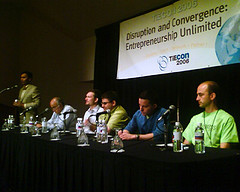There are there roles in a conference/ panel discussion:
- The Moderator – Guy Kawasaki has his advice for them: How To Be a Great Moderator.
- The Panelists – Paul Kedrosky takes care of them: Ten Rules for Being a Good Conference Panelist
- The Audience. How can you be “good audience”? The answer: don’t. Be Participants instead.
How? You can learn it here, at the Techdirt Greenhouse.  No, you don’t really have to be a Bay Area resident. Last time we had participants from Chicago, the UK … come on, it’s fun, and a life-changing experience: you won’t ever want to passively sit in a conference where the panel talks and you listen …or sleep.
No, you don’t really have to be a Bay Area resident. Last time we had participants from Chicago, the UK … come on, it’s fun, and a life-changing experience: you won’t ever want to passively sit in a conference where the panel talks and you listen …or sleep. ![]()
Tags: panelist, moderator, panel discussion, conference, unconference, techdirt, techdirt greenhouse, zoliblog

 The next
The next 
 Liveblogging
Liveblogging 
Recent Comments